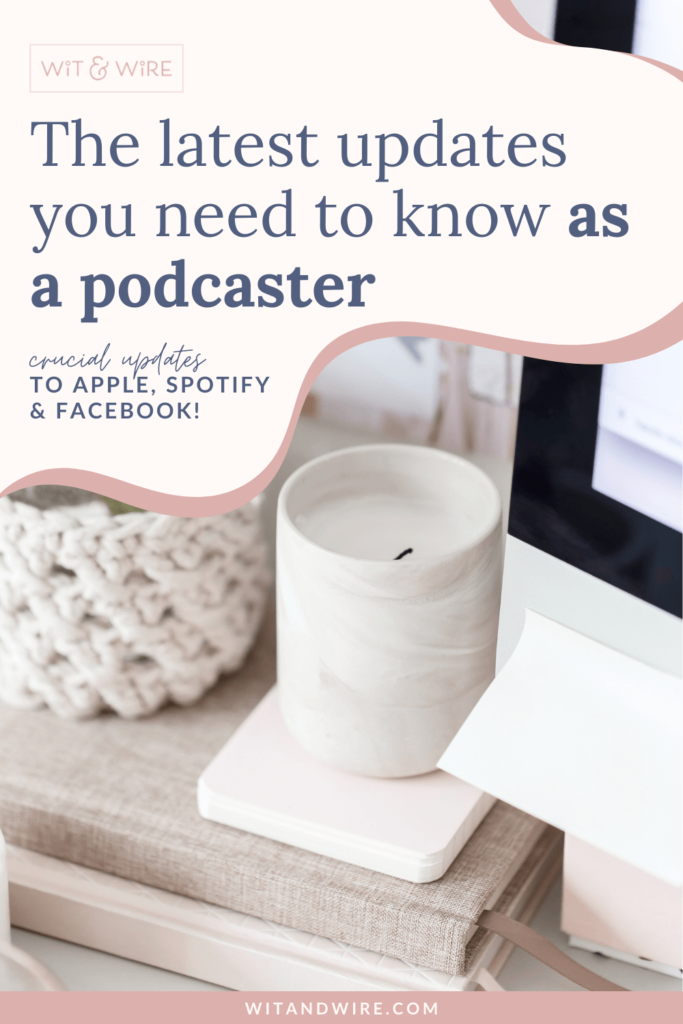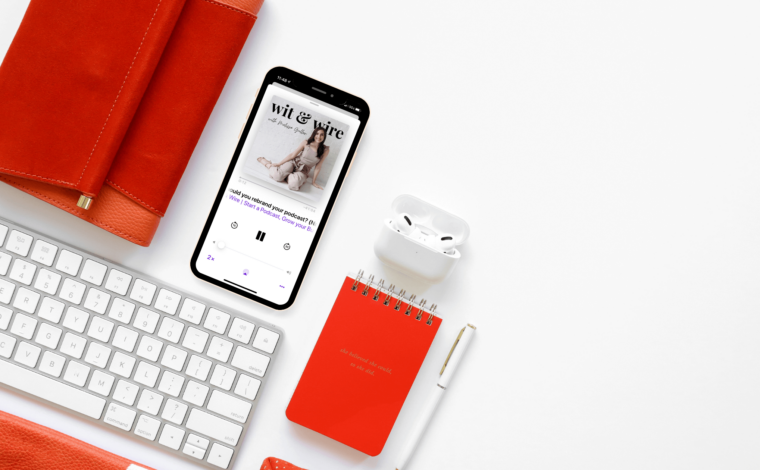In April 2020, Apple reported that they’d hit one million total podcasts. Then in April 2021, they reported that they’d hit two million.
This feels, at first, like massive, exponential growth, especially if you consider that the term “podcast” was first used in 2004, and it took until 2020 to hit that first million.
But I think numbers can be a little deceiving, so I wanted to break down why I don’t think any of you should be worried that there’s no space for you to start a podcast.
So today, I’m here to talk about what this new Apple milestone means for podcasting, plus I’ll cover the most important industry updates that have been announced since the beginning of 2021 from Apple, Google, Spotify, and a few other major players in the industry.
NOTE: This podcast was transcribed by a free AI transcription tool called Otter. Please forgive any typos or errors.
Melissa Guller 0:00
Welcome to the Wit & Wire Podcast, where we help podcast hosts climb the charts, turn a profit and make an impact. I’m your host, Melissa Guller. And in each episode, we share simple tips and creative strategies to help you create a binge worthy podcast that listeners love.
Melissa Guller 0:20
Welcome back podcasters. So last year in April of 2020, Apple reported that they’d hit 1 million total podcasts, which at the time sounded like a huge number. Then this month, just a year later, in April 2021. Now Apple is reporting that they’ve hit 2 million podcasts. This feels at first like it’s just massive exponential growth, especially if you consider that the term podcast was first used in 2004. And then it took until 2020 to hit that first million.
But honestly, I think that these numbers can be a little bit deceiving. So today, I want to break down why I don’t think any of you should be worried that there’s no space for you to start a podcast. It just isn’t true.
Then after my soapbox about this myth of 2 million podcasts, I did want to spend some time talking about the most important industry updates we’ve seen so far in podcasting in 2021. So in January, I released an episode called the top 10 trends in podcasting in 2021. And I shared a lot of great info in that episode. But because the podcast landscape is evolving so quickly, a lot has gone on and announcements have come out from Apple, Google and Spotify and a few others that I want all of you to be aware of. So I’m going to cover a lot in this short episode. And let’s just get started.
First up, I want to tell you why I don’t really believe that we should count the number of podcasts as 2 million. Yes, technically, that’s how many podcasts exist in Apple. But I did some research. And I have some citations in the show notes. But there’s a report from Steven Goldstein from amplify media. And he shared that of those 2 million podcasts. 1/4 of them are already out of business, or probably were never really in it at all. They only have one episode. That’s it, their little one hit wonders. And I know there are so many great reasons why people start a podcast that they don’t finish.
But I think knowing that 26% of all podcasts only have one episode helps you to understand just how small this world is. That said, this is just the tip of the iceberg. So I said that a fourth of podcasts only have one episode. But 44% of all podcasts have three episodes, or fewer. So if I were to get a little dramatic, that means that half of all podcasts only have three episodes or fewer. And now you can start to see why that 2 million number has quickly been brought down to maybe a million podcasts that could viably be in production, either now or in the past.
And all of these numbers on their own probably don’t mean much like a million podcasts. Is that a lot? Is that a little who’s to say, but I want you to ask yourself, how many blogs Do you think there are? Now I’m about to tell you the answer. And I had to rerecord this part a couple times because I kept saying 6 million. But that’s not the number. There are 600 million blogs out there. It’s just such a big number. I don’t even know how to help you visualize 600 million, that’s almost twice the population of the United States. But going back to the 2 million number from Apple, what I’ll say is that hopefully I’ve convinced you that it is not too crowded to launch a podcast. In fact, quite the opposite. There’s still so much opportunity, and hopefully I can help you launch your show or help it continue to grow. But 2 million podcasts tells Apple something important. It says people are creating podcasts and people are tuning in. And that means that they are finally after years of kind of scaling by doing something about the user experience of their app, and they’re paying attention to improvements for the future.
Melissa Guller 4:08
That brings me to the other major Q1 update that all podcasters and aspiring hosts should know about. And that is the update from the word subscribe in Apple podcasts to the word follow. So before you ask people to subscribe to your show, I’m sure that you’ve heard me say it if you’ve tuned into Wit & Wire before, but now you’re gonna start hearing me say follow Wit & Wire’s podcast on Apple.
And there are a lot of things going on behind this change. So I’m going to cover why I think they’re doing it and what you need to do right now to make changes going forward. So first of all, why do I think they’re changing the name? To me? The biggest reason is because the word subscribe makes a lot of people think payment. So I believe this is Apple’s attempt to help clarify that tuning into a podcast is free, particularly for new listeners. Popular as podcasting continue Used to be and obviously you are tuning in, you know what a podcast is.
Truthfully, a lot of people are still really new to the medium. Tom Edison from Edison research reported that 47% of people who have never listened to a podcast, do think that subscribing means that it will cost money. So I believe the biggest reason for Apple’s shift is because they don’t want this barrier to entry. They don’t want new podcast listeners who have never tuned into a single show, to believe that you have to pay in order to participate in podcasting. I think Spotify, Stitcher, Amazon, music and audible already use the word follow. And Google podcasts overcast and a few others still use the term subscribe, but I do think it’ll be interesting to see if there’s a ripple effect from Apple’s move.
I will say that when I was talking with some students in some of my Wit & Wire programs, we had a really interesting discussion around this change. And although we agree that the word follow is definitely more in line with social media accounts, so you could say, you know, follow Wit & Wire on Instagram, Facebook, and Apple podcasts. Now all in one breath, we’re kind of torn on if that’s a good thing. Following feels a little bit easier to do than subscribing. Because following feels fleeting I could follow or unfollow something, but subscribing feels kind of like a commitment. So maybe this word, this vocab update could help us in the long run. If listeners start getting used to following more of their favorite podcasts, instead of the word subscribe feeling kind of exclusive, like oh, I only want to curate just a few shows that I subscribe to.
Now, in the last few months, I’ve actually heard that Apple might take this change one step further, where the term subscribe will actually involve payment. And in the last years, so many apps have followed twitches lead to introduce micro revenue streams to support their creators. So what does that mean? a micro revenue stream is a way that you can pay very, very small amounts within an app to support your favorite creator. So twitch with gaming has been doing this for a long time.
But now for example, there are Instagram Live badges, which are a new way to tip creators in app with little hearts, they start as low as I think $1.99. And that’s not fully rolled out. But imagine tipping. If you tuned into an Instagram Live of your favorite yoga instructor and you wanted to show them a little love in the form of actual money, you can now do that seamlessly inside of Instagram.
There’s also something called YouTube channel memberships. In addition to just being able to subscribe to your favorite channel for free, viewers can support your channel through a small monthly payment in exchange for additional perks. And this is something you have to have at least 1000 subscribers to do if you are a YouTuber.
Now, I don’t think we’re about to see this feature from Apple, you know, within the next month or so. But within a year or two, I think it’s very possible. Apple to me is incentivized to allow people to purchase within the app to not only support the creators, but of course, to take a piece of that apple pie. So I expect that the word follower will have a meaning and that maybe the word subscriber will come to mean paying for something to support the podcaster in Apple in the future.
Melissa Guller 8:03
Now to me another question I’m curious about is Does this mean that Apple will start showing podcast follower counts? Right now you cannot see how many subscribers a podcast has an apple. Not only is it not public, it’s actually pretty well guarded from the host side, where Apple does not give you an exact number of people who have hit the subscribe button. So I sincerely hope that this term change from subscribed to follower will not involve any publicizing of metrics, because what I actually think is amazing about podcasting is that there aren’t vanity metrics. You can’t see how many followers you have, or how many channel subscribers you have.
And I think that really levels the playing field for new hosts to come in. All you can really see are the number of reviews and that’s why I think reviews are so important because, sure, maybe they influence Apple’s algorithm. But more importantly, they tell new listeners that people like your show, reviews are social proof. And when you see a podcast that has no reviews, compared to a podcast that has 70 reviews, it makes a huge difference. And even if 70 feels like a huge number, I sincerely think that getting 20 reviews makes a difference and makes your show look more legit. And so if you can hit that number, even with help from friends and family, I do think it’s important and well within the control of any podcast host. No matter how big or small your starting audience might be.
Back to my main point. I love the fact that you cannot see how many subscribers each podcast has. And I hope that Apple continues to keep that count private, but I guess we’ll wait and see in terms of when this goes into effect. This update may already be live for some people because it’s part of iOS 14.5 Which was scheduled for release in March of 2021. It’s currently April 2021. When this episode comes out, I’m guessing that some of us will have it and some of us won’t.
But this leads me to my final point on this update, which is, what do each of you need to do for your own podcast? Well, once the change does go into effect, we will all need to adjust our language and I think you can start right now. So instead of saying subscribe to your podcast, use the word follow to avoid alienating new podcast listeners. Now I know people are people, you’re still going to hear the word subscribe, but trust me, it is not too early to change your language.
And in this case, I think it’s good to be a trendsetter. I don’t think you need to wait at all. I don’t think you need to go back and edit past episodes because I think people will know that the word subscribe meant tuning in. But for now, I would just recommend moving forward using the word follow when you talk about your podcast. And here are a few places you might want to audit your show. First up is in your podcast. CTA is your calls to action. So for example, in your outro, and in the outro of this episode, you’ll hear me ask people to follow Wit & Wire podcast, you’ll also want to check your website. So is there any way that you ask people to subscribe to your show, because I know I do. Like if you go to Wit & wire.com slash podcast. That’s the main landing page for the show. And it used to have the term subscribe, and now I’ve switched over so it is the word follow.
So I would recommend going through the major pages of your site like your about page, your podcast landing page, and maybe your homepage. And that’s if you have your own full website for a business or a bigger brand. If your podcast site is just a podcast only website, then obviously you might need to do a bit of an audit through the whole thing. Lastly, I would check your marketing language. So if you have any upcoming social media posts or emails going out, I would make sure that you’re using the word follow and not the word subscribe.
Now Apple is still the number one player in the space by far. So 60 to 80% of your podcast listeners will come from Apple. And to me the biggest variable isn’t necessarily which app they use. It’s how people find your podcast. So Wit & Wire has a higher than average rate of people listening on my website, because my SEO and my Pinterest strategies continue to bring new people to my podcast. But those marketing strategies aside, when people use apps to listen, by far, the majority of them are still using Apple, Spotify is second, but it’s not a close second, it’s a distant second. However, they’ve made a lot of investments over the last few years, and their numbers are continuing to go up. So they are definitely important. And here are just a couple small updates from Spotify over the last quarter.
The first is that they’re updating their UI, which means their user interface for both Android and iOS apps, as of March 2021. And the reason why this matters is mostly because podcasts are more prominently featured on the homescreen. As I understand it, they’re going to be showing more of your podcast plays from the past three months on the recently played tab. So I think the hope is that if you get somebody to listen to one of your podcast episodes, they’ll kind of be reminded of that for a little bit longer. And hopefully, you can get them to continue tuning into your future episodes by being reminded of your podcast over time.
So I think that’s really exciting. I don’t know how we’re going to really be able to measure that impact individually. But I’m sure that this is just one more sign that Spotify wants podcasts in their app, which means that more people will continue using Spotify as their primary app.
Melissa Guller 12:55
The other Spotify update is actually about anchor which Spotify owns. So anchor is a free podcast hosting tool. And it’s a jack of all trades. It lets you record, edit, and publish your podcast for free. And I think for some people anchor is a great app, and I’m going to leave my full thoughts on anchor for another day.
They released a rebrand in Q1, which again just shows how much they are investing in that tool. My brief, I guess TLDR for today is that anchor is great for hobby podcasters. And it’s kind of the jack of all trades, it does a little bit of everything. But the editing tools are not that great if you’re really trying to be an editor, the recording tools are better elsewhere. If you want better quality, the publishing will give you significantly more data if you’re using a different app. However, I completely see the value of having a free tool and not paying for yet another thing for your podcast or your business.
And I would say two years ago I wouldn’t recommend anger really to anybody serious about growing their show. But in the last six to 12 months I will say that they are rolling out a lot of really compelling features. So I have added to my own personal backlog that I need to do a 2021 review of anger to really give my full opinion so let me know on Instagram send me a DM at Wit & Wire if you would like to see a future episode or a blog post talking more about anger and the past pros and cons.
Also, since I’m bringing it up in the show notes, I will share a link to my favorite podcast hosting platforms for 2021. Because I do have some clear favorites. So find a link to that in the show notes. And you’ll really get to see the full comparison, and which ones I recommend for which hosts.
Rounding out the big three of Apple, Spotify. And now Google podcasts, let’s talk about the updates to Google. Google podcasts is rolling out changes, they have a significantly easier to use podcast manager to submit your show and to see trends. And actually, my favorite quick tip is that if you log into the back end of your podcast in Google, you can see what search terms in Google are leading people to find your podcast, which is pretty cool.
Today, though, is all about the big update, in my opinion for Google podcasts, which is that Google is now automatically transcribing podcasts. Now, I don’t want this to come across as Oh, Google is transcribing a show and I can use that information. It’s really just for Google’s use. And there’s a clear reason in my mind why they’re doing this. And that is to improve search ability.
What I believe they’re trying to do is understand what we talked about in our episodes, and then transcribe that so that their AI can crawl those words, and that Google can better surface podcasts in search results. As you may know, Google acquired YouTube. And you’ve probably noticed over the last few years that when you search for something in Google, there is a critical section right at the top of the search, where Google actually recommends YouTube videos for you to listen to. And I think that Google is trying to do the same for podcast episodes.
And to me that’s fascinating for so many reasons. With Google being able to now listen to episodes, I think that’ll be really interesting to see how these search results pages change over time. Our more of our podcast episodes getting shown on page one, does Google prioritize YouTube videos, then podcast episodes than blog posts? Or how does that hierarchy fall? many big questions we do not have answers to yet, but something I’m keeping an eye on.
The only other very small Google podcasts update is that they’re playing around with personalized recommendations. kind of similar to how you see an apple below your podcast, you can see something like listeners also liked. So that’s just a small update. The by far bigger and more critical update is that they are now transcribing episodes so that they can listen so that they can query so that they can surface your podcast in Google in search results.
We’ve covered a lot about the big three apps, apple, Spotify, and Google. But to me, if there are two main takeaways, I would say you get from this episode, it would be this.
Number one, 2 million podcasts and Apple sounds like a lot. But compared to blogs, it’s still such a small number, because it’s still such an untapped medium. And remember how few podcasts even have more than one or more than three episodes. So there’s plenty of room for new shows to get started. And for existing shows to continue to grow. And to really hit the charts in your category.
Number two, Apple is changing the language from subscribe to follow. And that’s definitely something that all of us should start doing as well. So ask people to follow your podcast and keep a close eye on over the next couple of years how Apple might start to actually give us opportunities as hosts to earn money directly within their app.
Overall, those are the big two takeaways, but we covered quite a bit more, I would love to know what your biggest learning was. So if you’re tuning in, and you want to take a screenshot of this episode and share it on Instagram to a story, I always love hearing from listeners.
Melissa Guller 18:40
Thank you for tuning in to this episode of the Wit & Wire podcast. If you haven’t already, click the Follow button or it might still say subscribe in whatever app you’re choosing to listen and I know I mentioned so many resources. So you can find all of those in the show notes at Wit & wire.com slash 32. I do hope if you enjoyed this episode that you might go back through the archives maybe check out the top 10 podcasting trends in 2021 that I released in January it is Episode 21 ironically, and I hope you’ll hang out with me over on Instagram at Wit & Wire where I love to share more great tips for podcasters thank you again for joining me, Melissa Guller, in this episode of the Wit & Wire podcast. I’ll see you next time!





